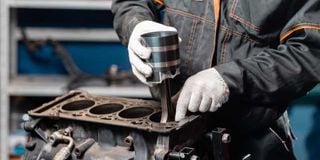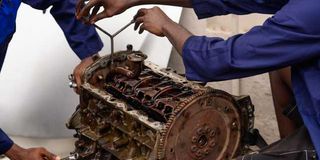How delay adds to the cost of engine fixes

Learn about critical symptoms like increased oil consumption and blue smoke that indicate serious engine wear.
What are the symptoms of serious engine wear? At what stage do these indicate the need for an engine overhaul? Joseph
Your engine is wearing out—to an infinitesimally small degree—every time you use it, from day one. On a car of good quality, treated with diligence and respect, the wear will be progressive but so slight that the engine will perform adequately for tens of thousands—even hundreds of thousands—of kilometres before an overhaul is needed.
An older engine will gradually have slightly reduced power—especially at lower revs, where “torque” is strongest, and less so at top revs, where horsepower peaks. That marginal loss of power is normal.
Wear becomes serious if either the oil needs to be topped up quite often between services or the exhaust emits blue smoke (burning oil, as opposed to black smoke which is unburnt diesel) when the engine is under load, and/or the power loss is severe. The benchmark for “acceptable” oil consumption is up to half a litre between services. If more than that is needed, or blue smoke is copious or constant, the power loss will be increasingly significant and it’s time for the workshop.
Engine overhauls vary considerably in their scope—usually involving new piston rings. Assuming your question is not entirely academic, in the early stages of excessive wear, the piston rings probably need to be replaced (because they are too worn, weak, or cracked).
The replacement parts are not expensive, but removing and dismantling the engine is a palaver, so while it is out and open it makes sense to renew or remedy several other things that might be nearing the end of their best service life – things like bearings, seals, parts of the valve gear, the timing belt, clearing carbon deposits and so on. Damaged rings might have scratched the piston skirts and cylinder walls and require sleeves and re-engineered sizing.
The longer the engine has been used in substandard conditions, the greater the consequential damage will be. So, if your car consumes oil, emits blue smoke, loses significant power, or makes a different noise, the sooner you get the problem diagnosed and fixed, the cheaper it will be. Delay will only increase the rate of wear and add (by multiples!) to the remedial cost.

Understanding the signs of engine wear can save you from costly repairs and extend your vehicle's lifespan.
Service is about much more than oil change
You have strongly urged readers to have their cars serviced regularly and recommended a benchmark interval of 5,000 km. Does that still apply if the owner uses top-of-the-range engine oils that claim to last 10,000 km or more? DLM
Yes. For several reasons. Even the best synthetic oils give “better” protection between 0 and 5,000 km than they do between 5,000 and 10,000. They constantly degrade. They never improve. And service is about much more than an engine oil change.
Above all it is about “checking everything” – expertly and thoroughly - and “servicing anything” that needs attention. Some service work is curative. The important majority is preventative.
To some extent, vehicle owners do that themselves every day by looking, listening, smelling, and feeling—all the time—and some do under-bonnet checks every few hundred kilometres when they refuel.
Things that are readily spotted when standing up outside the car or when driving it are “quite” well monitored.
But things deeper inside or underneath the vehicle (where most of its working parts are) are almost universally neglected by owners. Very, very few actively and expertly check gearbox and differential oil levels and condition, bushes and mountings, seals, or loose nuts, or brake lining wear, or leaks or cracks, or fuel and air filter condition, or chaffed or loose-hanging wires, etc.
If problems with these things are spotted early, the remedy is usually simple, quick and inexpensive with no harm in terms of consequential damage.
Or harbouring hidden risk. If your motoring conditions and driving conduct are gentle, all of these things might be fine for 10,000 (or even 25,000 ) km. Maybe. But maybe not.
Almost everything on your car is suffering wear all the time – over years of use. And can suffer damage or failure at any time – in an instant.
Think of that in terms of an extreme example to understand the principle: if you get a puncture that causes rapid deflation of a tyre (which can happen to anybody) and you promptly stop within 50 metres and change the wheel, fixing the punctured tyre will cost you a few hundred bobs.
If you continue to drive on the flat tyre for 500 metres, the tyre will probably be destroyed and replacing it will cost you tens of thousands of shillings.
In various ways, that “principle” applies to any fault, breakage or maladjustment. The maxim that “prevention is better than cure” is no less valid because it is humdrum.
So where does the figure of 5,000 km come from?
In the early years of motoring, service was conducted when necessary—that meant every day and often in the middle of a trip.
As the technology became more reliable, it was based on the necessary oil change interval: initially 1,000 km, then 3,000 between the Wars, and then 5,000 for most of the 20th century.
The logic was that if you had to take the car to a garage to change the oil, it made sense to have other things checked and serviced at the same time.
It is only in the past couple of decades that “long-life” oil has been developed and synthetic formulae have made that potential even stronger. So why not evolve the service intervals as well?
While the oil might be more resilient, many other things are not, so an expert preventive/remedy check of the many other things listed here still needs to be done, especially if motoring conditions are harsh.
So the logic has inverted from service when you change the oil to changing the oil when you need to service.
In relatively gentle conditions, changing top-grade oils at every service is not essential – merely convenient and optimal (however marginally) for your engine.
The 5,000 km benchmark is well informed by experience, but any number as precise as that in such a wide range of variables is a guideline. It is a compromise between optimal and reasonable. You are the judge for yourself and your car.
I try to follow that as best I can, but do not have anxiety attacks if I am sometimes a bit late, and am very ready to shorten the gap if I’m either planning or just returning from a tough (wilderness) safari.
The guideline in that instance is to have the service check done a couple of weeks before the safari starts (a shake-down period) and as promptly as possible when it ends.
And, of course, double-check every day during the safari itself – not expecting an incipient fault to develop, but to ensure that it does not.
That, not just an oil change, is what service does.


